Saving Belize’s Scarlet Macaws: Into the Wild (Pt. 1)
The Scarlet Macaw is one of Belize’s most stunning birds, but its bright colors and loud calls make it an easy target for poachers. In the Chiquibul, Friends for Conservation and Development is working tirelessly to protect these rare macaws and give them a fighting chance to survive and thrive in the wild. Digital Editor Hipolito Novelo returned to the Chiquibul for part one of ‘Saving Belize’s Scarlet Macaws: Into the Wild’. Here is that report:
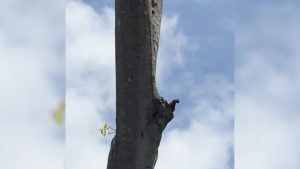 Hipolito Novelo, Reporting
Hipolito Novelo, Reporting
Deep in the emerald heart of the Chiquibul Forest, a flash of crimson breaks through the canopy. It’s a pair of Scarlet Macaws, one of Belize’s rarest treasures, gliding free above ancient trees and winding rivers that have cradled its kind for centuries. It’s a rare view that many Belizeans have not seen for themselves. And further down the bank, another rare sight: a scarlet macaw peeking from its nest in a quamwood tree.

Wilmer Guerra
Wilmer Guerra, Biodiversity Researcher, FCD
“So about 90% of their nests are around this river. They nest in the riparian zone. So they find these quamwood trees, which are softwood trees. They would find a cavity that’s very small, and then they would go in and using their claws, they would scratch the walls of the cavity to create chippings for the chicks.”
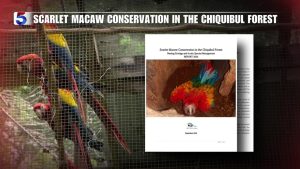 Once seen soaring in flocks across Central America, today only about 300 to 350 remain in Belize, squeezed into the wild corridors of the Chiquibul and the riparian forests of the majestic rivers. But this brilliant bird’s story is at a crossroads. For security reasons, the precise location of these scarlet macaws is not being shared, to avoid putting them at greater risk.
Once seen soaring in flocks across Central America, today only about 300 to 350 remain in Belize, squeezed into the wild corridors of the Chiquibul and the riparian forests of the majestic rivers. But this brilliant bird’s story is at a crossroads. For security reasons, the precise location of these scarlet macaws is not being shared, to avoid putting them at greater risk.
A new report from Friends for Conservation and Development (FCD), which has spent over a decade guarding and studying these vibrant birds, reveals both hope and urgency in the race to ensure the Scarlet Macaws continue to thrive in the wild.

Rafael Manzanero
Rafael Manzanero, Executive Director, FCD
“These macaws we have in Belize is a subspecies. So it is only found in Mexico, Guatemala, and Belize, and in small numbers. Here in Belize, they’re still on their red list in terms of its poor and low numbers that we still have in the country. We spend basically seven months in doing biomonitoring and doing other programs in terms of protecting the species. We have at least five interventions that we have to do in terms of looking at the population increase. So it takes a lot of commitment, it takes a lot of skills, and more importantly, a lot of experience in order to do this kind of work.”
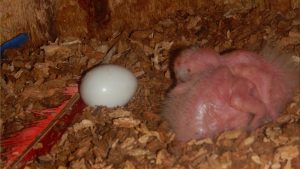 FCD’s dedicated rangers climb towering Quam Wood trees, nestle themselves into the jungles for two weeks shifts, and watch over fragile nests, all to protect eggs no bigger than a clenched fist. The work they do is non-evasive and critical to the bird’s survival. The team uses a slingshot to shoot a fishing line with a sinker over a branch. They pull a stronger line through to set up the climbing rope. With harness and safety gear, the rangers ascend and uses a belay line to descend.
FCD’s dedicated rangers climb towering Quam Wood trees, nestle themselves into the jungles for two weeks shifts, and watch over fragile nests, all to protect eggs no bigger than a clenched fist. The work they do is non-evasive and critical to the bird’s survival. The team uses a slingshot to shoot a fishing line with a sinker over a branch. They pull a stronger line through to set up the climbing rope. With harness and safety gear, the rangers ascend and uses a belay line to descend.
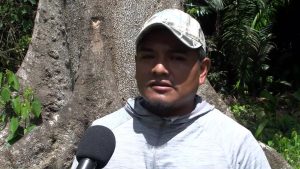
Eric Max
Eric Max, Chief Researcher, FCD
“The climbing demands a lot of physical fitness because some of the trees are high. Like today, he climbed, this one is not really high, but it does demand a lot of physical fitness.”
In the 2024 season alone, 21 nests were monitored, 57 eggs were laid, and 28 chicks took their first flight. For those in danger, a field laboratory became a lifeline. There, chicks too weak to compete for food or whose nests collapsed in storms were hand-fed, nurtured, and prepared for release back into the forest.
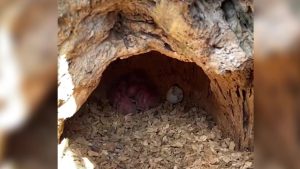 Eric Max
Eric Max
“It’s a non-invasive job, so we don’t touch the Macaws. We just normally look at them and see what they’re doing, how they’re growing. We see their feathers. We see inside the cavity condition what it’s like if it’s not vulnerable to like rain and predators and stuff like that. So that’s what we’re looking for and to ensure that they’re accounted for, which is main, the main target. We identify cavities on the quamwood because these tree, they’re soft wood and the macaws have a really bright color. So as we are going throughout Chiquibul and checking the areas, you would see them like poking their head out. And then immediately, you know that they’re inside because it’s just their head that they’re poking out.”
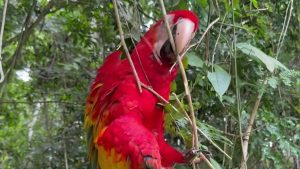 And unfortunately, this works against them. The Scarlet Macaws’ loud calls, brilliant colors, and their constant squawking from high nests makes them easy targets for Guatemalan poachers.
And unfortunately, this works against them. The Scarlet Macaws’ loud calls, brilliant colors, and their constant squawking from high nests makes them easy targets for Guatemalan poachers.
Wilmer Guerra
“When we are canoeing up and they hear you, if they’re inside nest, the first thing that they would do is they would poke their head out and they’re very bright red. So you easily for you to spot them and then they start to vocalize. So even if you’re far away, you would be able to hear them. And so for a poacher, that’s something that’s really good for him, right? For us it’s also good because then we can easily identify a nest. But for a poacher also, it’s very good for him if he comes in to try to take the chicks.”
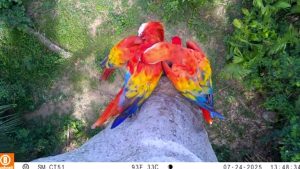 So at-risk chicks are taken to the research station where they are raised and later released. This week, FCD released 12 of the birds. There home now is the Chiquibul forest.
So at-risk chicks are taken to the research station where they are raised and later released. This week, FCD released 12 of the birds. There home now is the Chiquibul forest.
Wilmer Guerra
“They are here for a little over a hundred days. They are between a hundred and a hundred and twenty days old which is when we know is the age we need to release them. Some of them are rescue from areas where we know are areas to be poached. So before the poachers get to them we extract them and then we bring them to the lab and following a lot of protocols then we raise them and then release them into the wild.”
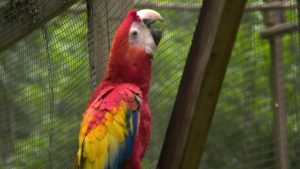 But the fight is far from over. Poachers still lurk where rangers cannot reach, and hungry chainsaws threaten the nesting trees macaws need to breed. Yet, the past year’s success, zero poached nests in monitored areas, shows what’s possible with FCD’s invaluable work.
But the fight is far from over. Poachers still lurk where rangers cannot reach, and hungry chainsaws threaten the nesting trees macaws need to breed. Yet, the past year’s success, zero poached nests in monitored areas, shows what’s possible with FCD’s invaluable work.
Rafael Manzanero
“We have seen around 2008, we had up to 86% of the eggs that were being lost as a result of poaching or the chicks. So that has decreased up to zero over the last four years. In these zones here. So, but it has taken a lot of work, it has taken through bi-national arrangements with Guatemalans. We have been able to put also anti-poaching activities for that. And so over the years this has been reduced, but it took us goodness, some 10 years really to reduce that.”
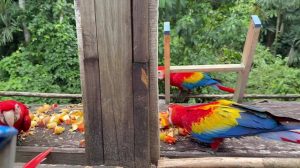 Ten years of tireless protection, the Scarlet Macaw population in Belize has risen from just over 200 to around 300–350 today. This is a clear sign that FCD’s unwavering commitment is giving these magnificent birds a fighting chance. Reporting for News Five, I am Hipolito Novelo.
Ten years of tireless protection, the Scarlet Macaw population in Belize has risen from just over 200 to around 300–350 today. This is a clear sign that FCD’s unwavering commitment is giving these magnificent birds a fighting chance. Reporting for News Five, I am Hipolito Novelo.
In Part Two, we’ll take you inside the hidden world of illegal wildlife trade, showing how Belize’s Scarlet Macaws are stolen from their nests, smuggled across borders into Guatemala, and trafficked as far as Asia. We’ll also reveal how much poachers make, how the trade works, and what’s being done to stop it.




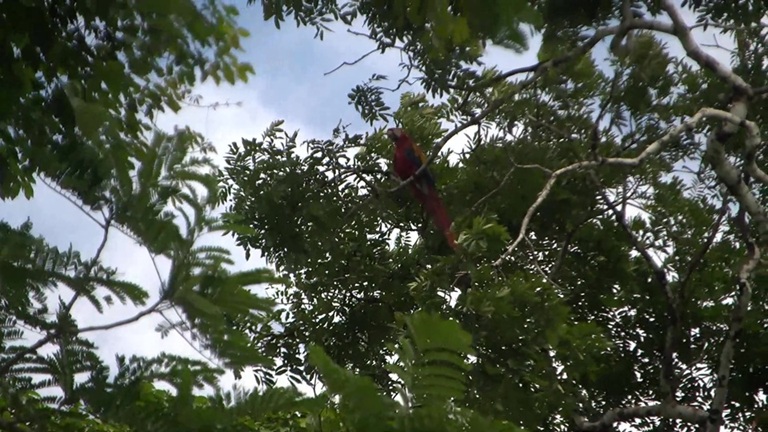

Facebook Comments